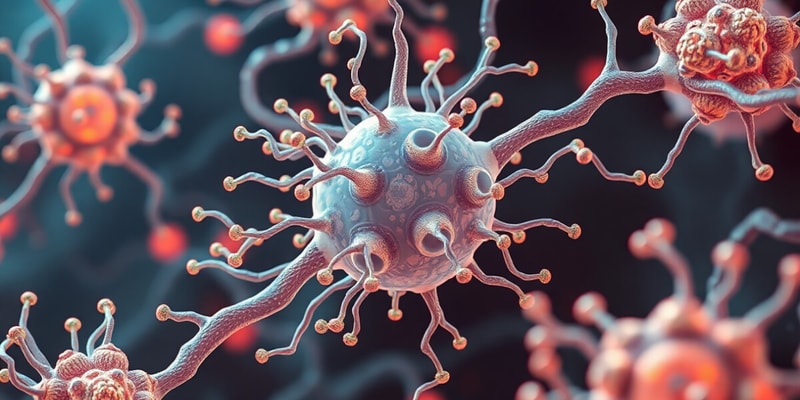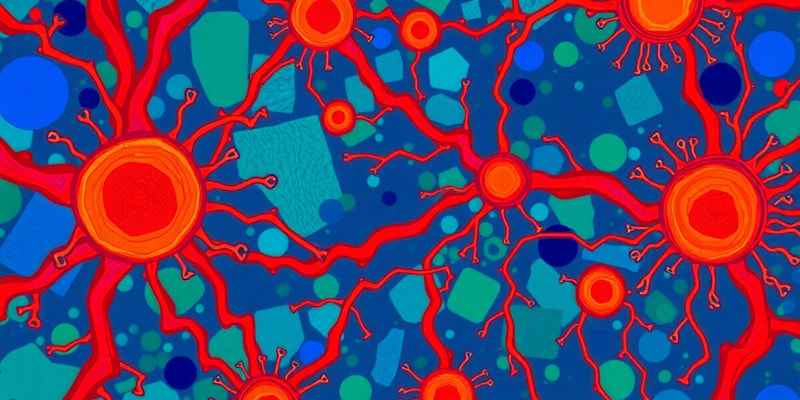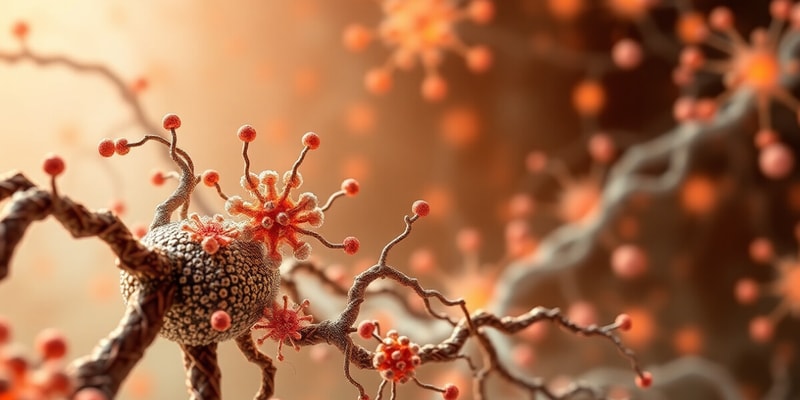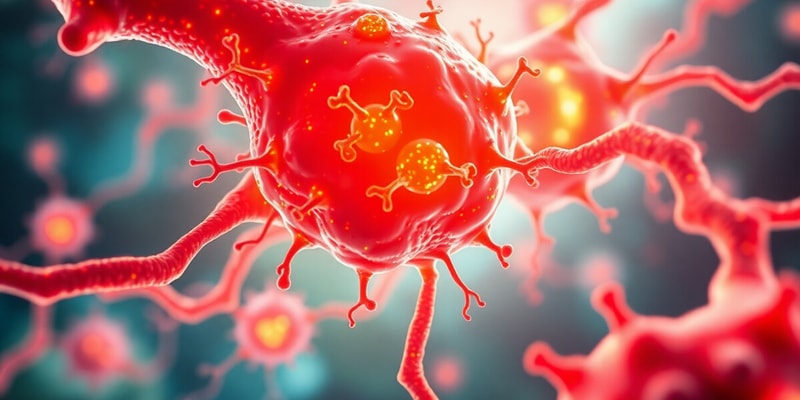Podcast Beta
Questions and Answers
What primarily defines the variability in the TCR α and β chains?
What role does a non-receptor tyrosine kinase play in receptor activation?
Which co-receptor is responsible for interacting with class I MHC molecules?
Which of the following statements is true regarding receptor tyrosine kinases (RTKs)?
Signup and view all the answers
In mature αβ T cells, which statement about CD4 and CD8 expression is correct?
Signup and view all the answers
What is the primary functional role of the immune synapse?
Signup and view all the answers
What is the primary function of nuclear hormone receptors?
Signup and view all the answers
How do G protein-coupled receptors (GPCRs) activate G proteins?
Signup and view all the answers
What characterizes the CD4 protein structure?
Signup and view all the answers
What is a unique feature of Notch family receptors?
Signup and view all the answers
Which statement is true regarding CD8 molecules?
Signup and view all the answers
What is a primary role of the variable regions in TCRs?
Signup and view all the answers
Which ligands are primarily recognized by G protein-coupled receptors?
Signup and view all the answers
What is the main consequence of the activation of RTKs upon ligand binding?
Signup and view all the answers
Which part of the TCR complex interacts with costimulatory receptors during T cell activation?
Signup and view all the answers
Which aspect is primarily influenced by nuclear receptors?
Signup and view all the answers
What is the primary role of cell surface receptors in signal transduction?
Signup and view all the answers
What is cross-linking in the context of cell surface receptors?
Signup and view all the answers
What type of receptors are intracellular and activated by lipid soluble ligands?
Signup and view all the answers
Which of the following is a characteristic event in the signal transduction pathway?
Signup and view all the answers
What enzymatic action do protein kinases perform in signaling pathways?
Signup and view all the answers
Which statement accurately describes the process of internalization in relation to cell surface receptors?
Signup and view all the answers
Which part of a receptor is directly involved in the initiation of intracellular signaling?
Signup and view all the answers
How do extracellular ligands typically interact with cell surface receptors?
Signup and view all the answers
Which statement accurately describes non-receptor tyrosine kinases?
Signup and view all the answers
What is a defining characteristic of receptor tyrosine kinases (RTKs)?
Signup and view all the answers
Which of the following receptors contain immunoreceptor tyrosine-based activation motifs (ITAMs)?
Signup and view all the answers
What feature is associated with inhibitory receptors in the immune system?
Signup and view all the answers
How is the T cell receptor (TCR) for antigen characterized?
Signup and view all the answers
What role do nuclear receptors play when activated by lipid soluble ligands?
Signup and view all the answers
Which statement about the T cell receptor (TCR) binding domain is true?
Signup and view all the answers
What is the function of the associated polypeptide chains in immune receptors?
Signup and view all the answers
What role does the synapse play in T cell activation?
Signup and view all the answers
Which of the following transcription factors is NOT critical for T cell responses?
Signup and view all the answers
What initiates the phosphorylation of ITAMs in the context of T cell receptor (TCR) activation?
Signup and view all the answers
Which component is primarily involved in basal tyrosine phosphorylation before TCR activation?
Signup and view all the answers
Why is activation of multiple transcription factors necessary for T cell responses?
Signup and view all the answers
Study Notes
Cell Surface Receptors
- Cells have specific surface receptors that interact with external ligands
- These receptors initiate intracellular signaling, cell adhesion, and internalization of molecules and cells
- Signal transduction involves a series of events: a cytosolic phase where proteins are modified, followed by a nuclear phase where transcription factors activate gene expression
Cell Surface Receptors and Signal Transduction
- Receptors initiating these responses are found on the plasma membrane, detecting ligands, or structures in neighboring cells or the extracellular matrix
- Nuclear receptors are located intracellularly and are activated by lipid-soluble ligands that cross the plasma membrane
- Ligand binding triggers either receptor clustering or conformational change, initiating downstream signaling
Signal Transduction - Phosphorylation
- A key early step is the addition of a phosphate group (phosphorylation) onto a tyrosine, serine, or threonine amino acid in the receptor or associated proteins
- Protein kinases catalyze this phosphorylation process
- For example, Protein tyrosine kinase specifically phosphorylates tyrosine residues
Categories of Cellular Receptors
- Non-receptor tyrosine kinases: Lack intrinsic catalytic activity, but utilize a separate intracellular tyrosine kinase for activation
- Receptor tyrosine kinases (RTKs): Possess an intrinsic tyrosine kinase domain that gets activated by multivalent ligand binding
- Nuclear receptors: Act as transcription factors, often activated by lipid-soluble ligands
- G protein–coupled receptors (GPCRs): Couple with GTP-binding proteins (G proteins), initiating signaling cascades upon ligand binding
- Receptor proteins of the Notch family: Important in development, their activation leads to receptor cleavage and nuclear translocation of the cleaved domain
Immune Receptor Family
- Immune receptors contain separate polypeptide chains for ligand recognition and other associated polypeptide chains that have cytosolic Immunoreceptor tyrosine-based activation motifs (ITAMs)
- ITAMs are found on the B cell receptor (BCR), the T cell receptor (TCR), and the high-affinity receptor for IgE (FcεRI)
- Inhibitory receptors in the immune system typically possess Immunoreceptor tyrosine-based inhibition motifs (ITIMs) on the same chain that recognizes ligands
T Cell Receptor (TCR) for Antigen
- The antigen receptor on T cells consists of a heterodimer of two transmembrane polypeptide chains: TCR α and β, linked by a disulfide bridge
- The antigen-binding site is formed by the Vβ and Vα domains
- The hypervariable loops at the top of the TCR are responsible for recognizing peptide-MHC complexes
Binding of TCR to an MHC molecule
- The V regions of TCR α and β chains have hypervariable segments called complementarity-determining regions (CDRs)
- Together, three CDRs from each chain form the specific recognition site for peptide-MHC complexes
Components of the TCR Complex
- CD4 and CD8: Coreceptors that bind non-polymorphic regions of MHC molecules to facilitate TCR signaling
- CD3: A complex of five transmembrane proteins (ε, γ, δ, ζ, ε) that transduce signals from the TCR
- ζ chain: Contains ITAM motifs essential for signal transduction
Role of CD4 and CD8 Coreceptors in T Cell Activation
- CD4: Binds to Class II MHC molecules and possesses four extracellular Ig-like domains, a transmembrane region, and a cytoplasmic tail
- CD8: Exists as a heterodimer of CD8α and CD8β chains, each with an Ig domain, a transmembrane region, and a cytoplasmic tail
- CD8 binds to Class I MHC molecules
The Immune Synapse
- A stable contact established between an antigen-specific T cell and an antigen-presenting cell (APC), forming a signaling platform
- It facilitates prolonged and effective T cell signaling by concentrating TCR complex, coreceptors, costimulatory receptors, and adaptors
- It ensures targeted delivery of secretory granules and cytokines from the T cell to the APC or target cell
Signal Transduction: TCR Complex Activation
- Phosphorylation of proteins and lipids is central to signal transduction from the TCR complex
- Lck, a Src-family kinase, phosphorylates the ITAMs of the CD3 and ζ chains, initiating signaling pathways
Calcium- and Protein Kinase C-Mediated Signaling Pathways in T Lymphocytes
- Activation of the TCR complex triggers a complex cascade involving calcium signaling, protein kinase C activation, and other signaling molecules
- This culminates in the activation of transcription factors that drive T cell gene expression and function
Activation of Transcription Factors
- Different signaling pathways activate distinct transcription factors, contributing to diverse T cell responses
- Key transcription factors activated in T cells by antigen recognition include:
- Nuclear factor of activated T cells (NFAT)
- AP-1
- NF-κB
- These factors regulate gene expression for cytokine receptors and effector molecules, allowing T cells to mount specific responses
Studying That Suits You
Use AI to generate personalized quizzes and flashcards to suit your learning preferences.
Related Documents
Description
Explore the fascinating world of cell surface receptors and their role in signal transduction. This quiz delves into the mechanisms of how receptors detect ligands, initiate intracellular signaling processes, and influence gene expression. Learn about the phosphorylation processes and the different types of receptors involved.




